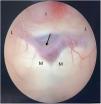The irrigation of the thalamus depends mainly on the thalamoperforating arteries. There are many anatomical variations in these arteries, the best known being the artery of Percheron. We report a case of a 13-year-old male presented with headache and decline in his mental status. Imaging features showed obstructive hydrocephalus secondary to a mass at the level of the mesencephalon so an endoscopic third ventriculostomy was performed. During the procedure a thalamoperforating artery was encountered at the level of the tuber cinereum limiting the perforation of the third ventricle floor. The present case emphasizes the importance of knowing the anatomy of these arteries and the identification of their main variants during neurosurgical procedures.
La irrigación talámica depende principalmente de las arterias talamoperforantes. Existen muchas variantes anatómicas en el origen y disposición de estas arterias siendo la más conocida la denominada arteria de Percheron. En este artículo presentamos el caso de un varón de 13 años que acudió a urgencias por cefalea y deterioro del nivel de consciencia. En las pruebas de imagen se evidenció una hidrocefalia obstructiva secundaria a una tumoración mesencefálica, motivo por el cual se decidió realizar una ventriculostomía endoscópica. Durante el procedimiento se evidenció una arteria talamoperforante a nivel del tuber cinereum que limitó la fenestración del suelo del tercer ventrículo. A partir de este caso destacamos la importancia de conocer la anatomía de estas arterias con sus posibles variantes y su identificación durante los procedimientos neuroquirúrgicos.
Article

If it is the first time you have accessed you can obtain your credentials by contacting Elsevier Spain in suscripciones@elsevier.com or by calling our Customer Service at902 88 87 40 if you are calling from Spain or at +34 932 418 800 (from 9 to 18h., GMT + 1) if you are calling outside of Spain.
If you already have your login data, please click here .
If you have forgotten your password you can you can recover it by clicking here and selecting the option ¿I have forgotten my password¿.










